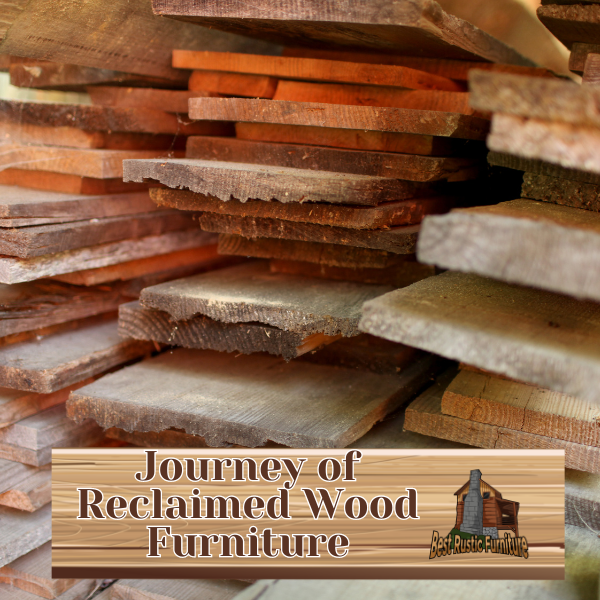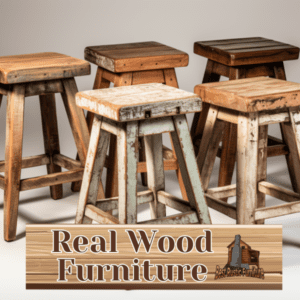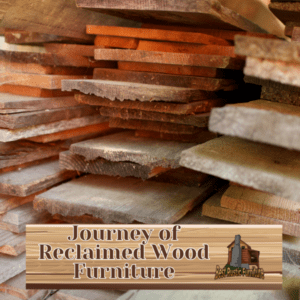
Reclaimed wood furniture, also known as salvaged or upcycled wood furniture, has gained significant popularity in recent years for its unique charm and sustainable qualities. The journey of reclaimed wood furniture encompasses a rich history, evolving techniques, and a growing appreciation for its environmental benefits. This article will explore the origins and evolution of reclaimed wood furniture, the reasons behind its popularity, the process of reclaiming wood, and the advantages and considerations of using reclaimed wood. We will also delve into the future of this eco-friendly and innovative furniture trend. Through understanding the journey of reclaimed wood furniture, we can appreciate its historical significance, aesthetic appeal, and positive impact on the environment.
Key takeaways:
- Reclaimed wood furniture is an environmentally friendly choice: By using old wood, this furniture helps reduce deforestation and minimize the carbon footprint associated with the production of new furniture.
- Reclaimed wood furniture adds character and unique aesthetics to any space: Each piece of reclaimed wood has a story to tell and distinct features, making it a popular choice for those seeking a one-of-a-kind look.
- The future of reclaimed wood furniture looks promising: With increasing awareness of sustainability and conscious consumerism, the demand for reclaimed wood furniture is expected to grow, leading to more innovation and creative design in the industry.
The History of Reclaimed Wood Furniture
Discover the captivating story behind reclaimed wood furniture as we embark on a journey through its intriguing history. Uncover the origins of this sustainable art form, tracing it back to its humble beginnings. Witness the evolution of techniques that have transformed reclaimed wood into stunning and functional pieces of furniture. Join us as we unravel the rich tapestry of reclaimed wood furniture, from its inception to the present day, and gain a newfound appreciation for its timeless beauty and environmental significance.
Origins of Reclaimed Wood Furniture
The origins of reclaimed wood furniture can be traced back to the need for sustainable and eco-friendly alternatives to traditional furniture materials. Initially, reclaimed wood furniture was born out of necessity, with people repurposing old wood from barns, factories, and other structures. Over time, it evolved into a craft and art form, with artisans refining techniques to preserve the unique character and history of the wood. Today, reclaimed wood furniture continues to grow in popularity due to its rustic charm, environmental benefits, and the desire for conscious consumerism. By choosing reclaimed wood furniture, individuals can bring a piece of history into their homes while supporting sustainability efforts.
Evolution of Reclaimed Wood Furniture Techniques
The evolution of reclaimed wood furniture techniques has revolutionized the industry, contributing to its popularity and appeal. Initially, craftsmen focused on antique restoration, recognizing the value in repurposing materials. As the demand for unique and aesthetically pleasing furniture grew, artists started experimenting with different finishes and designs, resulting in artistic creations. Traditional techniques like dovetail joints and mortise-and-tenon joinery were refined and combined with modern methods to enhance durability, showcasing innovative joinery. Woodworking machinery, such as CNC routers and laser cutters, played a crucial role in allowing for intricate detailing and precise shaping, representing the use of precision machinery. In order to maintain the integrity and beauty of reclaimed wood, sustainable finishes were developed, such as natural oils and water-based varnishes, making sustainable finishes an integral part of the process. The evolution of reclaimed wood furniture techniques has transformed the industry, offering consumers the opportunity to add sustainable and unique pieces to their homes.
The Popularity and Appeal of Reclaimed Wood Furniture
Reclaimed wood furniture has taken the design world by storm, capturing the hearts of eco-conscious individuals and those seeking a touch of uniqueness in their spaces. In this section, we’ll explore the reasons behind the soaring popularity and innate appeal of reclaimed wood furniture. We’ll discover the environmental benefits that make it a sustainable choice, delve into the unique aesthetics and character it brings to any setting, and uncover how it has become a prominent design trend in creating a sustainable and eco-friendly home.
Environmental Benefits of Reclaimed Wood Furniture
Environmental Benefits of Reclaimed Wood Furniture
Reclaimed wood furniture provides a wide range of environmental benefits that contribute to sustainability and conscious consumerism. By utilizing reclaimed wood, this type of furniture helps reduce deforestation. Through decreasing the demand for new trees, it plays a crucial role in preserving forests and habitats.
One of the significant advantages of reclaimed wood furniture is minimizing landfill waste. By repurposing wood that would otherwise end up in landfills, it effectively reduces waste and lowers greenhouse gas emissions.
Another environmental benefit is the energy-efficient production of reclaimed wood furniture. Compared to the harvest and processing of new timber, repurposing reclaimed wood requires significantly less energy.
Furthermore, reclaimed wood furniture plays a vital role in reducing the carbon footprint. As this wood has already absorbed carbon dioxide during its previous lifespan, it helps offset carbon emissions.
Additionally, the promotion of resource conservation is a key aspect of reclaimed wood furniture. By repurposing existing wood, it conserves valuable and limited resources, thus reducing the need for new materials.
In summary, the environmental benefits of reclaimed wood furniture are substantial. From reducing deforestation and landfill waste to energy-efficient production and carbon footprint reduction, it promotes sustainable and conscious consumerism.
Unique Aesthetics and Character
The unique aesthetics and character of reclaimed wood furniture make it a popular choice among consumers. The natural variations in color, grain patterns, and textures of reclaimed wood create a one-of-a-kind piece with a rich history. Each imperfection tells a story, adding charm and character to the furniture. The age and weathering of the wood give it a distinct patina that cannot be replicated. With reclaimed wood furniture, you can enjoy both the beauty of nature and the uniqueness of a truly individual piece in your home.
Sustainable and Eco-Friendly Design Trend
Sustainable and eco-friendly design is a growing trend in the furniture industry, and reclaimed wood furniture is at the forefront of this movement.
- Minimizes deforestation and reduces waste by repurposing old wood.
- Reduces carbon footprint by avoiding the energy-intensive process of harvesting new wood.
- Preserves natural resources by utilizing existing materials.
- Creates a unique and rustic aesthetic, adding character to any space.
Pro-tip: When shopping for reclaimed wood furniture, look for certifications such as FSC or SFI to ensure the materials are responsibly sourced.
The Process of Reclaiming Wood for Furniture
Delving into the fascinating realm of reclaimed wood furniture, we embark on a journey through the process of reclaiming wood for these unique creations. We’ll uncover the art of sourcing and selecting reclaimed wood, discover the meticulous steps of cleaning and preparing the wood, unveil the secrets of restoring and treating it, and witness the transformative process of crafting reclaimed wood into stunning furniture pieces. Get ready to explore the remarkable world of reclaimed wood and witness the beauty that lies within its history.
Sourcing and Selecting Reclaimed Wood
When sourcing and selecting reclaimed wood for furniture, there are several factors to consider to ensure quality and suitability.
| Authenticity | Species | Quality | Certifications | Sustainability | Compatibility |
|---|---|---|---|---|---|
| When sourcing and selecting reclaimed wood for furniture, it is important to verify the wood’s origin and history to ensure it is truly reclaimed and not illegally harvested. | Different tree species have varying characteristics, so when sourcing and selecting reclaimed wood for furniture, it is crucial to choose one that fits the desired aesthetic and functional requirements. | When sourcing and selecting reclaimed wood for furniture, it is necessary to assess the condition of the reclaimed wood, looking for structural integrity and minimal defects. | When sourcing and selecting reclaimed wood for furniture, it is advisable to look for certifications like FSC (Forest Stewardship Council) to ensure the wood has been sustainably sourced. | When sourcing and selecting reclaimed wood for furniture, it is recommended to opt for wood that comes from old buildings, barns, or other sources that prevent the need for cutting down new trees. | When sourcing and selecting reclaimed wood for furniture, it is essential to consider the specific design and construction needs of the furniture piece to ensure the reclaimed wood meets those requirements. |
Cleaning and Preparing Reclaimed Wood
Cleaning and preparing reclaimed wood is a crucial process in the transformation of the wood into furniture. To accomplish this, you need to follow these steps:
- Inspect the wood: Begin by carefully examining the wood for any embedded nails, screws, or other metal fasteners.
- Eliminate metal fasteners: Use a pry bar or a hammer to cautiously remove any screws or nails.
- Sand the wood: Employ a sander or sandpaper to eliminate any dirt, grime, or old finish from the wood’s surface.
- Clean the wood: Take a soft brush or cloth and gently remove any remaining debris or dust from the wood.
- Treat the wood: Apply a wood cleaner or conditioner to revive the wood’s natural beauty and safeguard it from future damage.
- Allow the wood to dry: Before proceeding to the next step, ensure that the wood dries completely by letting it air dry.
By adhering to these guidelines, you will guarantee that the reclaimed wood is immaculate, smooth, and ready to be transformed into exquisite furniture.
Restoring and Treating Reclaimed Wood
- Sourcing: Find reputable suppliers who offer reclaimed wood that is free from contaminants and structural damage.
- Cleaning: Remove dirt, dust, and old finishes using gentle methods such as sanding or using a soft brush.
- Repairing: Address any structural issues by filling in cracks, reattaching loose parts, or replacing damaged sections.
- Treating: Apply a suitable wood treatment, such as sealant or stain, to restore and protect the reclaimed wood from moisture, insects, and decay.
By following these steps, craftsmen can revitalize and preserve the unique character of reclaimed wood while ensuring its durability and longevity.
Crafting Reclaimed Wood into Furniture
Crafting Reclaimed Wood into Furniture involves a series of significant steps that must be followed diligently:
- Firstly, sourcing and selecting reclaimed wood is crucial. It is important to find high-quality wood from sustainable sources, such as old buildings or furniture.
- Next, cleaning and preparing the reclaimed wood is essential. Remove all nails, screws, and any other debris from the wood. Additionally, ensure that the surfaces are sanded and cleaned thoroughly. This ensures that they are smooth and ready for crafting.
- Moreover, restoring and treating the reclaimed wood is vital. It is necessary to apply appropriate treatments that enhance the wood’s durability, stability, and appearance. This may involve sanding, staining, or applying protective coatings to the wood.
- Furthermore, cutting and shaping the wood is a crucial step. Utilize precise measurements and cutting tools to create the desired pieces for the furniture. Shape the wood according to the design and functionality of the furniture.
- In addition, joining and assembling the wooden pieces is essential. Implement strong and reliable joinery techniques to connect the different pieces of wood together. This may involve techniques such as mortise and tenon, doweling, or using adhesives.
- Lastly, add the finishing touches to the furniture. This includes incorporating final details and finishes, such as decorative accents, hardware, or upholstery. Ensure that everything is secure and polished.
Crafting reclaimed wood into furniture demands skill, patience, and creativity. It is a process that transforms aged wood into functional and beautiful pieces, contributing to the sustainable and eco-friendly design trend.
The Advantages and Considerations of Reclaimed Wood Furniture
Reclaimed wood furniture has captured the hearts and homes of many, and it’s time to uncover its advantages and considerations. Hold on tight as we delve into the durability and strength that reclaimed wood offers, the unique challenges and maintenance it entails, and the pricing and value it brings to your space. Get ready to explore the fascinating world of reclaimed wood furniture and discover why it has become a beloved choice for those seeking both style and sustainability.
Durability and Strength
Durability and strength are fundamental considerations when selecting reclaimed wood furniture. The age and exposure to different weather conditions make reclaimed wood highly durable. Having already withstood the test of time, it proves to be a dependable choice. The proper restoration and treatment processes further enhance the strength of reclaimed wood. By addressing any existing damage or weaknesses, reclaimed wood furniture can be strengthened to ensure its long-lasting durability. Investing in such furniture not only adds character and charm to your space but also guarantees a robust and resilient piece.
Unique Challenges and Maintenance
Maintaining and caring for reclaimed wood furniture comes with its unique challenges and maintenance requirements. Here are some key considerations for ensuring the longevity of your furniture:
- Moisture: Reclaimed wood is more susceptible to moisture damage. It’s important to keep the furniture away from damp areas and use protective coatings to mitigate this unique challenge.
- Delicate finishes: The aged and weathered nature of reclaimed wood may have delicate finishes. Extra care is needed to prevent scratches or damage during cleaning, which is an essential aspect of its maintenance.
- Insect infestation: Due to its previous exposure to nature, reclaimed wood can be prone to insect infestations. Regular inspections and preventative measures are essential to tackle this maintenance issue.
- Shrinkage and expansion: Reclaimed wood may experience shrinkage or expansion due to environmental changes. Proper acclimation and humidity control are necessary to avoid warping or cracking, which is part of the ongoing maintenance.
- Maintenance products: Using appropriate maintenance products specifically designed for reclaimed wood helps preserve its unique beauty and characteristics. This aspect of maintenance is crucial in enhancing and protecting its natural allure.
Pricing and Value
The pricing and value considerations for reclaimed wood furniture can vary significantly depending on several factors. These factors include the quality of the reclaimed wood, the level of craftsmanship involved, and the demand for such furniture in the market.
To better understand the pricing and value aspects, let’s take a look at a breakdown of these considerations:
| Category | Considerations |
| Price Range | Reclaimed wood furniture can fall into a wide price range, from affordable options to high-end pieces. The pricing is influenced by factors such as the brand and the level of craftsmanship involved. |
| Longevity | One of the notable qualities of reclaimed wood furniture is its durability and resilience. This type of furniture is known for lasting for generations, adding value in terms of longevity. |
| Unique Character | Each piece of reclaimed wood used in furniture has its own history and character. This uniqueness contributes to the value and appeal of the furniture, making it standout. |
| Ethical and Sustainable Choice | Opting for reclaimed wood furniture is an ethical and sustainable choice. By choosing this type of furniture, you support sustainable practices and help reduce the demand for new wood, thus promoting environmental conservation. |
| Investment | High-quality reclaimed wood furniture has the potential to appreciate in value over time, making it an investment worth considering. Its timeless appeal and durability can contribute to its future market demand and value. |
The Future of Reclaimed Wood Furniture
Brace yourselves for an exciting glimpse into the future of reclaimed wood furniture! Get ready to witness a wave of innovation and creative design, as well as an unprecedented surge in its adoption and availability. But that’s not all – sustainability and conscious consumerism are also set to play a pivotal role. The future holds endless possibilities for this eco-friendly and storied material, so join us on this journey as we explore the exciting sub-sections that lie ahead!
Innovation and Creative Design
Innovation and creative design play a pivotal role in the evolution of reclaimed wood furniture. Designers and craftsmen tirelessly strive to push the boundaries and create one-of-a-kind, functional pieces.
- By embracing experimental techniques, they constantly explore novel methods of treatments and finishes, including the use of unconventional materials and the integration of modern technology.
- Reclaimed wood furniture offers a canvas for artistic expression, allowing designers to showcase their creativity by incorporating captivating shapes, textures, and patterns into their stunning pieces.
- With customization as a priority, designers can tailor reclaimed wood furniture to cater to individual preferences, offering personalized options that perfectly meet the unique needs of their clients.
- By skillfully combining reclaimed wood with materials like metal or glass, they produce visually striking and contemporary designs that captivate and inspire.
- Reclaimed wood furniture serves as a remarkable platform for sustainable design practices, promoting eco-conscious consumer choices and offering sustainable solutions.
Increased Adoption and Availability
The growing consumer awareness and demand for sustainable and eco-friendly products have resulted in the increased adoption and availability of reclaimed wood furniture. As individuals become more conscious of the environmental impact of their choices, they are embracing furniture made from reclaimed wood. This surge in demand has paved the way for expanded options and greater availability in the market. Numerous furniture manufacturers and retailers now offer reclaimed wood furniture as a viable choice. Due to this increased adoption and availability, reclaimed wood furniture is no longer limited to a niche market but has become a mainstream and highly desirable option for those who are seeking stylish and eco-conscious furniture.
Sustainability and Conscious Consumerism
Sustainability and conscious consumerism are paramount factors to consider when it comes to reclaimed wood furniture. Here are some important points to keep in mind:
- Reducing deforestation: By opting for reclaimed wood, you actively support endeavors to preserve forests and decrease the need for new timber.
- Reducing waste: Reclaiming wood from old structures or furniture prevents it from being discarded in landfills, thus promoting a circular economy.
- Promoting ethical practices: Opting for reclaimed wood means endorsing artisans and businesses that prioritize ethical sourcing and production methods.
- Unique and one-of-a-kind pieces: Reclaimed wood furniture carries an exceptional narrative and character, which adds an authentic touch to your space.
When purchasing reclaimed wood furniture, seek certifications or guarantees of sustainability. Additionally, consider collaborating with local artisans or exploring second-hand options to further encourage conscious consumerism.
Frequently Asked Questions
1. What is reclaimed wood furniture and why is it unique?
Reclaimed wood furniture refers to furniture made using wood sourced from old homes, barns, historical buildings, or other structures. It is unique because the wood used is often decades or even centuries old, having weathered and developed unique qualities over time.
2. How is reclaimed wood obtained for furniture making?
Reclaimed wood can be found in various places such as dumpsters, factories, neighbor’s yards, and lumber yards. Some furniture makers, like Landrum Tables, partner with construction companies to source reclaimed wood from projects in specific locations like Charleston, SC.
3. What are the challenges of working with reclaimed wood?
Working with reclaimed wood can be complex and time-consuming. Safety measures, like using a metal detector to find hidden hardware such as nails and screws, need to be taken. Moisture can also be a problem, requiring the wood to be dried to a moisture level of 12% or below to prevent warping. Additionally, insect infestations may need to be addressed.
4. What unique characteristics are preserved in reclaimed wood furniture?
Reclaimed wood furniture preserves the unique characteristics of each piece of wood, such as nail holes, notches, cracks, stains, and old brands. These features add to the furniture’s beauty and serve as a tribute to its history and heritage.
5. How is reclaimed wood stabilized for furniture making?
Reclaimed wood can be stabilized through various methods. Kiln-drying is commonly used to reduce moisture content and prevent warping. Other techniques may also be employed to ensure the wood is stable and suitable for crafting furniture.
6. What are some examples of furniture made from reclaimed wood?
Furniture makers create a wide range of items using reclaimed wood, including tables, benches, picture frames, candle holders, and lamp bases. Each piece carries a unique story and charm derived from the wood’s history and the structures it originated from.






